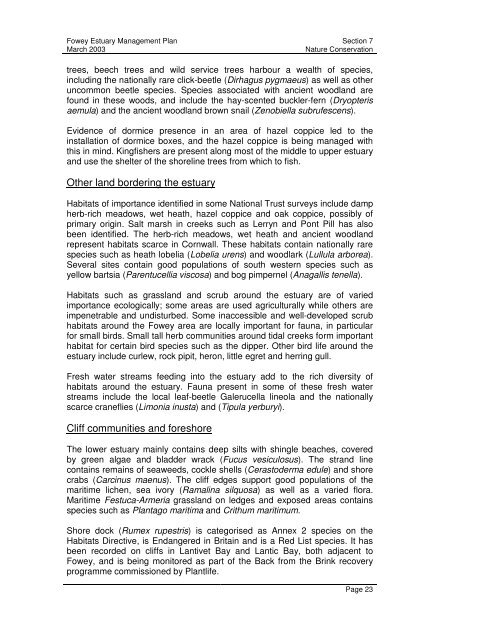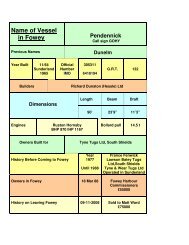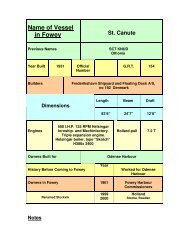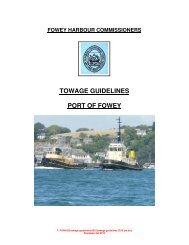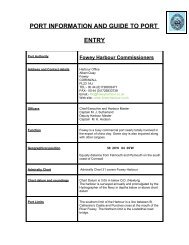Fowey Estuary Management Plan Fowey Estuary ... - Fowey Harbour
Fowey Estuary Management Plan Fowey Estuary ... - Fowey Harbour
Fowey Estuary Management Plan Fowey Estuary ... - Fowey Harbour
Create successful ePaper yourself
Turn your PDF publications into a flip-book with our unique Google optimized e-Paper software.
<strong>Fowey</strong> <strong>Estuary</strong> <strong>Management</strong> <strong>Plan</strong> Section 7<br />
March 2003 Nature Conservation<br />
trees, beech trees and wild service trees harbour a wealth of species,<br />
including the nationally rare click-beetle (Dirhagus pygmaeus) as well as other<br />
uncommon beetle species. Species associated with ancient woodland are<br />
found in these woods, and include the hay-scented buckler-fern (Dryopteris<br />
aemula) and the ancient woodland brown snail (Zenobiella subrufescens).<br />
Evidence of dormice presence in an area of hazel coppice led to the<br />
installation of dormice boxes, and the hazel coppice is being managed with<br />
this in mind. Kingfishers are present along most of the middle to upper estuary<br />
and use the shelter of the shoreline trees from which to fish.<br />
Other land bordering the estuary<br />
Habitats of importance identified in some National Trust surveys include damp<br />
herb-rich meadows, wet heath, hazel coppice and oak coppice, possibly of<br />
primary origin. Salt marsh in creeks such as Lerryn and Pont Pill has also<br />
been identified. The herb-rich meadows, wet heath and ancient woodland<br />
represent habitats scarce in Cornwall. These habitats contain nationally rare<br />
species such as heath lobelia (Lobelia urens) and woodlark (Lullula arborea).<br />
Several sites contain good populations of south western species such as<br />
yellow bartsia (Parentucellia viscosa) and bog pimpernel (Anagallis tenella).<br />
Habitats such as grassland and scrub around the estuary are of varied<br />
importance ecologically; some areas are used agriculturally while others are<br />
impenetrable and undisturbed. Some inaccessible and well-developed scrub<br />
habitats around the <strong>Fowey</strong> area are locally important for fauna, in particular<br />
for small birds. Small tall herb communities around tidal creeks form important<br />
habitat for certain bird species such as the dipper. Other bird life around the<br />
estuary include curlew, rock pipit, heron, little egret and herring gull.<br />
Fresh water streams feeding into the estuary add to the rich diversity of<br />
habitats around the estuary. Fauna present in some of these fresh water<br />
streams include the local leaf-beetle Galerucella lineola and the nationally<br />
scarce craneflies (Limonia inusta) and (Tipula yerburyi).<br />
Cliff communities and foreshore<br />
The lower estuary mainly contains deep silts with shingle beaches, covered<br />
by green algae and bladder wrack (Fucus vesiculosus). The strand line<br />
contains remains of seaweeds, cockle shells (Cerastoderma edule) and shore<br />
crabs (Carcinus maenus). The cliff edges support good populations of the<br />
maritime lichen, sea ivory (Ramalina silquosa) as well as a varied flora.<br />
Maritime Festuca-Armeria grassland on ledges and exposed areas contains<br />
species such as <strong>Plan</strong>tago maritima and Crithum maritimum.<br />
Shore dock (Rumex rupestris) is categorised as Annex 2 species on the<br />
Habitats Directive, is Endangered in Britain and is a Red List species. It has<br />
been recorded on cliffs in Lantivet Bay and Lantic Bay, both adjacent to<br />
<strong>Fowey</strong>, and is being monitored as part of the Back from the Brink recovery<br />
programme commissioned by <strong>Plan</strong>tlife.<br />
Page 23


